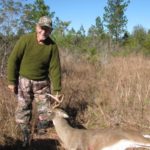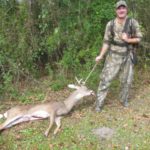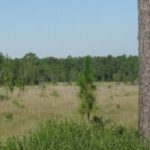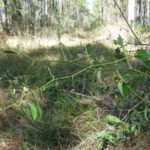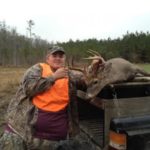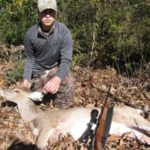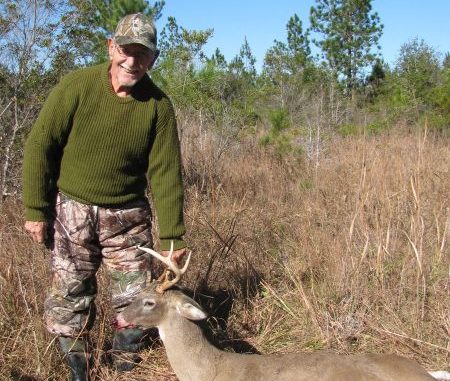
Hunting in the Southeast Louisiana piney woods isn’t about setting up in pretty, open bottoms. Instead, it’s about deciphering barely visible signs.
It was a tall order. You see, Doc’s nephew Kyle was bored with duck hunting. So his dad Gus finally had an excuse to bring him over for a weekend to Da Deer Camp.
This was weird, because from his junior-high chums Kyle had long heard that deer hunting was “MEGA-boring!”
And it’s hard to fault his chums. After all, their “hunting” mostly consisted of spending hour after hour after hour in box-stands over food plots without sight of a shootable creature.
And let’s face it: At their age the definition of a “shootable creature” is pretty broad. From rabbits to squirrels, from armadillos to raccoons, from coyotes to crows, from Coke cans to Slim-Jim wrappers.
At any rate, during this “mega-boredom,” Kyle’s friends had managed to survive by texting each other every few seconds to ameliorate the torpor.
But given his last few years of duck hunting at his family lease near Myrtle Grove, Kyle simply could not imagine that any type of hunting could possibly be more boring than the duck hunting he’d come to know and loath.
This hunting, of course, was radically different from the duck hunting his dad and granddad and uncles and older cousins had enjoyed in the same area for generations — even if they often relied on dos gris for hot shooting and spicy gumbo.
Indeed, a few windy mornings blasting away at flock after decoying flock of kamikaze dos gris were often the perfect ticket to get the young ’uns into duck hunting BIG-TIME!…
But alas, in the words of Benny Grunch and the Bunch: “Dey ain’t dere no more.”
At any rate, some areas in Louisiana — say the Mississippi River delta region from East Carroll down to Avoyelles parishes — could give Kyle’s chums a much different take on deer hunting than “mega-boring.” Unfortunately, most of them hunted in Southeast Louisiana’s piney timberlands — not exactly the Texas Hill Country or Midwest farm country when it comes to deer sightings, much less shootings.
So to spice things up, Gus decided to introduce his son to the entire deer-hunting experience — which is mostly scouting, of course.
The actual shooting — the climax if you will — is an infinitesimal component of the sport. And if this shooting takes place without having had any hand in the preparatory work, there’s a big element missing.
In other words, without the proper foreplay, the gratification quotient is only a fraction of what it could (and should) be.
Or so reasoned Gus, who’d slowly idled over to deer hunting as what he’d known as duck hunting (in Southeast Louisiana) gradually faded to a shadow of its former self.
If nothing else, the LSU-Bama game would liven up the weekend. And while arranging and collecting for the pool, Gus paraded out his son with his spanking-new deer-hunting gear — to Artie’s horror.
“Man!” Artie snorted” Ya can’t use that duck-hunting camo for deer hunting! Ya gotta be outcha-mind! Think dem deer are stupid? Here try this.”
And Artie reached around, grabbed an oak-tree camo parka hanging behind him on the rack, and handed it to Kyle.
“This oughta work for ya. With that marsh camo, dem deer will see ya a mile off!”
“You might want this tree-bark face mask, too,” Eddie added. “So those deer won’t see ya.”
“And those boots ain’t gonna cut it, either,” Pelayo contributed. “Here. I got an old pair with oak-leaf camo exterior. They’re kinda small for me. Oughta fit you.”
“And these camo gloves, too,” Doc chimed in. “So those deer won’t see the glare from your hands.
“And for heaven’s sake DON’T forget this blaze-orange vest!” Artie finished up. “Four hundred square inches of it. It’s very, very important!”
Kyle seemed mystified.
“But …?” he started to ask.
“What?!” Artie quickly interrupted. “Heck no, man! Are you nuts?! Dem deer can’t see this blaze orange. Only other hunters can. So it keeps ya safe.”
“Man I’d always heard duck hunters were crazy,” Gus gasped while looking around. “Somebody here’s obviously out their mind, but I don’t think it’s Kyle!”
Hunt deer in Southeast Louisiana’s piney woods — the area Kyle had the misfortune to start with — and you hunt among the most-abominable deer-hunting terrain on the continent.
The abominations are many and varied.
First off, low deer numbers per acre. This isn’t fertile farmland or bottomland hardwood mixed with soybean fields. Southeast Louisiana from Denham Springs to Slidell has the type of sandy soil best for growing pine trees (as do the central, western and northwestern portions of our state.)
Deer don’t eat the pine trees themselves, but they eat just about everything that sprouts in profusion between them: greenbriar (smilax), blackberry, french mullberry, privet, muscadine, arrowhead and yaupon.
Worse (for hunters, but good for deer), most of this stuff is evergreen. So visibility is almost as miserable in October as January.
Clear-cuts, select-cuts and a few skinny bottoms offer the only relief. Heck, just drive I-12 from Slidell to Denham Springs, and look at the mess. It gives some deer hunters from Mid-west farm country the creeps.
Here’s endless thickets of pines, jungles of yaupon, mountains of briars, carpets of greenbriar — most of it evergreen. And except for the odd power-line. It never opens up.
Hence the box stands that dot them seemingly every 200 yards. What a joke!
So what’s a feeding area in this expanse? Answer: The whole thing.
What’s a bedding area? Answer: See previous answer.
What’s a travel corridor? Where’s those nice, brushy fence rows, churned with tracks leading from one soybean or corn field to another?
Deer can live their whole lives in that mess and never be seen by human eyes — during the day that is.
The opener was actually a week away, so Gus and Kyle were intent on scouting on the Bama-LSU weekend. If Kyle shot (or even saw) a deer in the coming weeks he wanted to feel he had a hand in hunting it.
So after the father-son team’s first morning of scouting, Pelayo tagged along to offer his own scouting advice.
Naturally Gus and Kyle promptly brought us over to a nice little “bottom” (one of the few on the lease.) Naturally it was among the first areas that drew their attention — and sure enough it was “pretty.”
And sure enough, it seemed crisscrossed with fresh deer tracks.
“OK, class,” Pelayo began his lesson, while pointing to the trees around him. “Not all bottoms are created equal. If a bottom contains oaks and if these oaks are dropping acorns (mostly laurel oaks in this area), sure, it’s a good place to set up.
“But other bottoms — like this one — contain mainly gum or poplar trees. These produce no deer food, but make ideal climbing stand sites to face up AWAY from the bottom to the better-used trails.”
As always happens, the mud in bottoms captures every deer track and keeps them fresh-looking for days. But, in fact, most deer don’t regularly travel in the bottom itself (especially if it consists of gum trees.) It’s just that the relatively few times they do they leave such pretty tracks.
Most deer trails run parallel to the bottom but generally around where the pines meet the hardwoods. Tracks don’t show up so nicely on these pine-needle carpeted areas, but if you look close (and know what to look for) you’ll usually find browsing sign and droppings in a semblance of a pattern along a semblance of a trail.
“Wow, look at all dem deer tracks!” Gus pointed as we moved up toward the pine-needle carpet.
So Pelayo bent down and inserted a finger deep into the “tracks.”
“See that?” he laughed. “Not deer tracks. They’re mostly armadillo rootings. Deer tracks are usually shallower than where raccoons and armadillos stick their paws and snouts into the needles.”
So we moved on, as Gus and Kyle nodded and grimaced at each other.
“Now these look like deer tracks,” Pelayo pointed, while calling Kyle over.
“I don’t see anything,” both Kyle and his Dad said, while peering down at the pine needles.
So Pelayo bent down and pointed at the slight depressions. And it was true that by themselves the slight depressions didn’t give much of a clue to deer travel in this area.
So Pelayo pointed at the foliage a few feet away, and then we walked a bit and came upon a muddy area that showed clear and fresh deer tracks. Then some fresh droppings, both in the Milk-Dud and Raisenet sizes.
When we find what we strongly suspect are deer tracks in the pine needles, we often follow the “trail” to where it comes to an open, muddy spot. Eight times out of 10 we find a crisscrossing of those nice, sharp tracks that get us all so pumped.
More importantly, we also look around for browse lines. Any smilax, privet, or ti-ti shrubs near our ambush stand sites MUST be heavily browsed.
These three plants constitute the “primary browse” in the areas we hunt (also in much of South Louisiana’s piney woods.)
But simply finding these plants isn’t enough. If they’re thick and lush, we move on. This means few deer habitually move through the area. If deer are moving through — they’re nipping it. Simple as that.
We followed this “trail” for a while and came upon a barely discernible shift in the landscape.
“Watch,” Pelayo motioned us over.
And, sure enough, more of those barely discernible deer tracks appeared along another clear browse line. Three of these trails intersected at the landscape shift.
“Never fails,” Pelayo smirked. “Wherever two landscapes meet, deer trails appear.”
The two different landscapes consisted simply of a 10-year pine select-cut meeting a five-year pine select cut — not exactly the Continental Divide.
The tracks in the mud also pointed toward a massive thicket of ti-ti, youpon and privet. In our experience, trails leading to what appear to be bedding areas are more reliable. Trails to what appear to be feeding areas tend to change during the season, as the food preferences change — as persimmons and white oak acorns run out, for instance, or as freezes kill preferred browse.
Trails to or through bedding areas (hellishly thick stuff) tend to remain more constant — at least in our experience.
Amazingly, little Kyle (and his dad Gus) were all ears (and eyes.) They seemed immensely interested in our woodland tour and lecture. That we were all fanatical fellow duck hunters greatly helped with the camaraderie and banter during the scouting tour.
That very evening we sweetened up the major trail intersection with a couple of sacks of corn — but spread far and wide, across about a 80-square-yard area.
And here Kyle put up his spanking-new climber for the third deer hunt of his life (and first from a climber.)
He seemed pumped.
My climber was already up about 200 yards away in similar terrain. Pelayo opted for his box stand, and Gus opted to sleep in.
By 9:15 the next Saturday morning (gorgeous with 30-degree temperatures and frost on the ground), my concentration was waning as I fidgeted in my climber 27 feet in a pine. I like these heights to look over the heavy brush of recently select-cut areas — so naturally a safety-belt and harness feature in my deer-hunting gear.
Suddenly, movement caught my eye. Another Cardinal?
Then I saw the ear flick.
Then the sun bounced off an antler.
“WOW!”
And the shakes started.
A (spindly) 6-pointer, at least! And he seemed in a hurry. He wasn’t moseying along feeding; he was headed somewhere in particular, not browsing or poking around in the manner of does and their young offspring.
My rifle was hanging from a limb, and the buck was so preoccupied it didn’t see me fumbling for it.
Finally the gun went up.
“Where’d he GO?”
I can’t find him through the scope! Up, down, around.
“AHH! There he is!”
The crosshairs danced as I gasped and fogged up the scope. Finally they steadied.
“Deep breath, now, “ I told myself. “AH! — There’s his shoulder. Steady now. Start — squeezing — but NOW he’s behind another tree! Hold off!
“Now he won’t stand still! He’s moving — still moving! I can’t steady the doggone crosshairs! Brace against the tree and lead him a bit. OK — but now he’s disappeared back into the brush!
“WAIT-A-MINUTE! Now here comes a doe from behind him! But that ain’t supposed to happen this time of year?!”
I was a basket case. Shaking like a leaf. My knees knocking, gasping.
“Looks like I blew it — YES, I blew it,” I finally convinced myself.
After a few minutes, I could finally think clearly. Well, at least both were moving in Kyle’s direction.
“Maybe?” I thought.
PE — TOAW! The blast came through loud and clear — and from Kyle’s direction.
Half an hour later, Pelayo and I were whooping and slapping Kyle on the back. He was jubilant, and still shaking and stuttering as he raised the doe by the ear in triumph.
He felt he’d hunted his first deer, and he was beaming.
“That’ll taste much better than those dos gris your dad and uncles keep telling you about,” Pelayo laughed. “We’ll show you at the tailgate party next week!”
